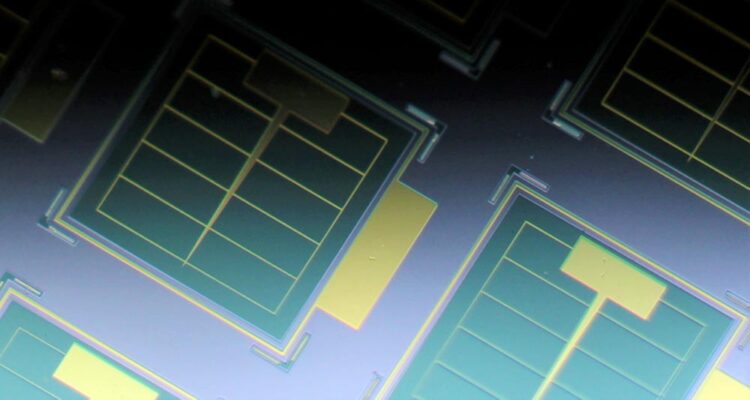Ultrathin solar cells promise improved satellite performance

Photo of ultrathin on-chip solar cells. The cells are the green squares and include an ultrathin layer of light-absorbing GaAs, which is key to their radiation tolerance. The surface of each green square is only 120 nanometers, about one-thousandth the thickness of a human hair, above the surrounding gray area. The gold-colored grids are electrically conducting metal contacts.
Credit: Armin Barthel
Radiation damage to photovoltaics in orbit can be reduced by making the cells thinner.
Most space satellites are powered by photovoltaic cells that convert sunlight to electricity. Exposure to certain types of radiation present in orbit can damage the devices, degrading their performance and limiting their lifetime.
In Journal of Applied Physics, by AIP Publishing, scientists from the University of Cambridge proposed a radiation-tolerant photovoltaic cell design that features an ultrathin layer of light-absorbing material.
When solar cells absorb light, they transfer its energy to negatively charged electrons in the material. These charge carriers are knocked free and generate a flow of electricity across the photovoltaic. Irradiation in space causes damage and lowers efficiency by displacing atoms in the solar cell material and reducing the lifetime of the charge carriers. Making photovoltaics thinner should increase their longevity because the charge carriers have less far to go during their shortened lifetimes.
As low Earth orbit becomes more cluttered with satellites, it becomes increasingly necessary to use middle Earth orbits, such as the Molniya orbit that passes through the center of Earth’s proton radiation belt. Radiation-tolerant cell designs will be needed for these higher orbits.
Another application for radiation-tolerant cells is the study of other planets and moons. For example, Europa, a moon of Jupiter, has one of the most severe radiation environments in the solar system. Landing a solar-powered spacecraft on Europa will require radiation-tolerant devices.
The investigators built two types of photovoltaic devices using the semiconductor gallium arsenide. One was an on-chip design built by layering several substances in a stack. The other design involved a silver back mirror to enhance light absorption.
To mimic the effects of radiation in space, the devices were bombarded with protons generated at the Dalton Cumbrian Nuclear Facility in the U.K. The performance of the photovoltaic devices before and after irradiation was studied using a technique known as cathodoluminescence that can give a measure of the amount of radiation damage. A second set of tests using a Compact Solar Simulator were carried out to determine how well the devices converted sunlight to power after being bombarded with protons.
“Our ultra-thin solar cell outperforms the previously studied, thicker devices for proton radiation above a certain threshold. The ultra-thin geometries offer favorable performance by two orders of magnitude relative to previous observations,” said author Armin Barthel.
The authors said that the improved performance of these ultra-thin cells is because the charge carriers live long enough to travel between terminals in the device.
Compared to thicker cells, nearly 3.5 times less cover glass is needed for the ultra-thin cells to deliver the same amount of power after 20 years of operation. This will translate to a lighter load and significant reduction in launch costs.
The article “Radiation effects in ultra-thin GaAs solar cells” is authored by Armin Barthel, Larkin Sayre, Gunnar Kusch, Rachel A. Oliver, and Louise C. Hirst. The article will appear in Journal of Applied Physics on Nov. 8, 2022 (DOI: 10.1063/5.0103381). After that date, it can be accessed at https://doi.org/10.1063/5.0103381.
ABOUT THE JOURNAL
The Journal of Applied Physics is an influential international journal publishing significant new experimental and theoretical results in all areas of applied physics. See https://aip.scitation.org/journal/jap.
Journal: Journal of Applied Physics
DOI: 10.1063/5.0103381
Article Title: Radiation effects in ultra-thin GaAs solar cells
Article Publication Date: 8-Nov-2022
Media Contact
Ashley Piccone
American Institute of Physics
media@aip.org
Office: 301.209.3090
All latest news from the category: Physics and Astronomy
This area deals with the fundamental laws and building blocks of nature and how they interact, the properties and the behavior of matter, and research into space and time and their structures.
innovations-report provides in-depth reports and articles on subjects such as astrophysics, laser technologies, nuclear, quantum, particle and solid-state physics, nanotechnologies, planetary research and findings (Mars, Venus) and developments related to the Hubble Telescope.
Newest articles

First-of-its-kind study uses remote sensing to monitor plastic debris in rivers and lakes
Remote sensing creates a cost-effective solution to monitoring plastic pollution. A first-of-its-kind study from researchers at the University of Minnesota Twin Cities shows how remote sensing can help monitor and…

Laser-based artificial neuron mimics nerve cell functions at lightning speed
With a processing speed a billion times faster than nature, chip-based laser neuron could help advance AI tasks such as pattern recognition and sequence prediction. Researchers have developed a laser-based…

Optimising the processing of plastic waste
Just one look in the yellow bin reveals a colourful jumble of different types of plastic. However, the purer and more uniform plastic waste is, the easier it is to…


